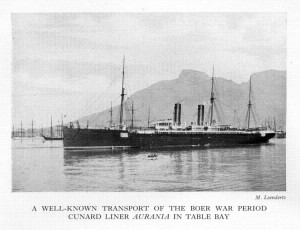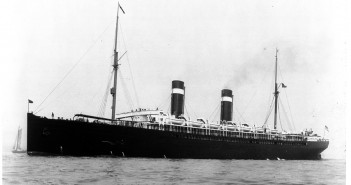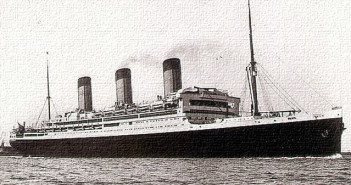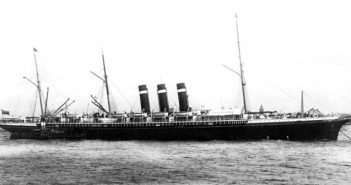In the wee hours of July 2, a fresh breeze sprang up. Aurania raised her anchor in another effort to make it to Quarantine under sail. She soon went out of control and drifted toward the shore. The crew took four hours to swing her around on the tide and get her speed up to four knots. By 7:30 that evening, the skies darkened, and she ran into heavy thunderstorms. She was out of control again at 4:30 the following morning. Her crew feared that she might end up in the West Indies because she kept on drifting away from shore. At last, by 8:50 that morning, a lookout spotted the approaching tugboat Germania, and everyone on board felt an immense relief. Both liner and tug were 77 miles east of Sandy Hook under a hazy sky. With hawsers passed and Germania’s help, Aurania managed a steady pace of three knots.
Aurania’s crew ensured the comfort of the passengers, who again lined the rails and watched for the lights of Fire Island. The ship’s band provided lively entertainment. The mood was cheery as many danced on deck to the music on that warm summer evening. Rockets soared skyward every hour to attract tugs and other vessels out searching for the crippled liner. The passengers thought the rockets were a part of the Fourth of July celebrations.
At 4:45 in the morning of July 4, the tugboat Luther C. Ward arrived and passed a hawser to Aurania’s port bow. With two tugs helping her, the liner picked up speed. In the afternoon, the steamer Virginia Seymour and tug W. Goodwin arrived to help. The Seymour ferried a third of Aurania’s cabin passengers and the mails to the Cunard pier. The Goodwin helped with towing. Aurania and her tugboats arrived at Quarantine shortly after 6 that evening. She was a wonderful sight to behold with her colours flying. By 8, she was safely at her pier.
The next day, July 5, dock crews discharged a quantity of her cargo. Crowds came to see her, but nobody boarded. Only those authorized to inspect the damage to her machinery could embark and go below decks. Since dry docking wasn’t necessary, Cunard contracted for emergency repairs at the pier.
In early August, Aurania sailed back to the Clyde under her own steam. Using only her low pressure boilers, she sailed at a respectable 10 to 12 knots. At J. & G. Thomson’s, she received a new set of machinery. In March 1884, she made the 200-mile trial run from Glasgow to Liverpool. The trip took less than 12 hours at a speed of 17.5 knots. On April 12, she returned to regular service.
To continue, click the NEXT button on the top of this page.





